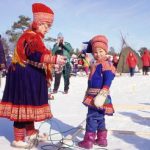Any image of the Ice Age gives us a wizened earth, barren and stony, abdicated to the powerful and relentless freezing of the poles. A few of these glaciers, silently introduced between high and mighty cliffs where lies modern day Scandinavia, would alter the landscape for millenniums to come. Amidst the Norweigan fjords, however, one relic did not stand the test of time. Pite Saami, related to the Finno-Ugric languages and other Saami languages spoken throughout Lapland, became extinct in Norway and is reduced to around 20 speakers in Arjeplog, Sweden according to Salminen (2007). The speakers are reindeer farmers who herd between the Pite river and the numerous inland lakes; who retained their bilingualism despite nomad schools that promoted Swedish exclusively, till a 1970s policy reversal. Additionally, Pite-Saami struggles from the shadow produced by the very-mediatized and widely spoken North Saami.
Most studies of the language were conducted over sixty years ago by German and Scandinavian researchers transcribing, translating, and offering analysis in their native languages. Interestingly, a Hungarian, named Halasz Ignácz, is reknown for his precursory work (19th century) on a dictionary and translation of religious texts. Much later, Joshua Wilbur working for the Pite Saami Documentation Project, provides detailed background information on the endangered language with an in-depth focus on grammar, all in English. Accordingly, some of the features of Pite Saami include germination, preaspiration, suppletion in the lexem for “small”, and negations expressed by a finite negation verb. For the occasional phonologist/orthography reader, talk of “plain singleton affricates” and “un-voiced alveolar and postalveolar phonemes” would be of special interest as well. Many of the characteristics, whether technical or not, resemble characteristics of Norwegian and Swedish, yet side-by-side comparison of the same texts show the distinctness of Pite-Saami. For instance, take these rather unpronounceable samples collected from Omniglot , “Derav er det minst 50 som framleis meir eller mindre kan snakke språket” is Norweigan for “Dassta li utsemus 50 almmatja ma ain máhtti gielav sagastit” (Pite Saami).
In this land of Christmas, because the ethnic group has converted to Christianity, drive reindeer, and live near the North Pole, “reindeer” are called “båtsoj”, “father” (as in father Christmas) is “áhttje” and “muähtagav” means “snow”, quite a complicated word for such a daily occurrence. However, even though the holiday season is approaching, “sapmi” for “territory of the Saami people” and “Svieriga” to denominate “Sweden” is a better start if the resurrection of this language is your mission, except, of course, if you lose you tour-guide during the snowmobile visit in which case you say “gunne’l dån?” (where are you?). All humor aside (although it can be a perilous situation) the context is important to note. Pite-Saami’s relative in Russia, Ter Saami, is only spoken by two people, and officially the world’s smallest language. An article about them or about Ume Saami (10 speakers in Sweden) could have been written, but the result would have been more nostalgic than anything. However, the recent multi-media documentation projects with audio and video recordings for Pite-Saami, undertaken by several European universities, is less than nostalgic and a breath of fresh air in terms of linguistic preservation, or should we say “icy air”?




